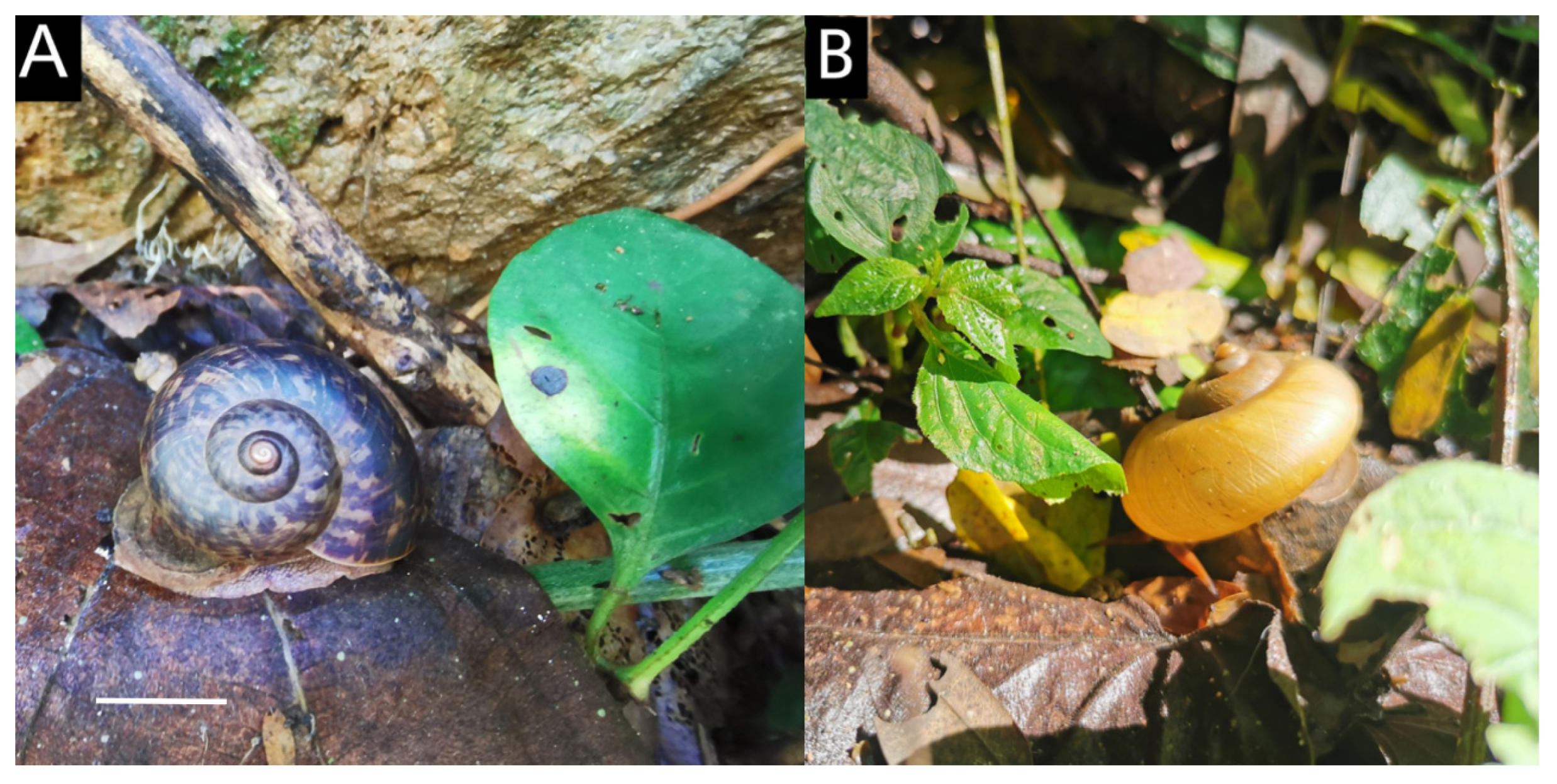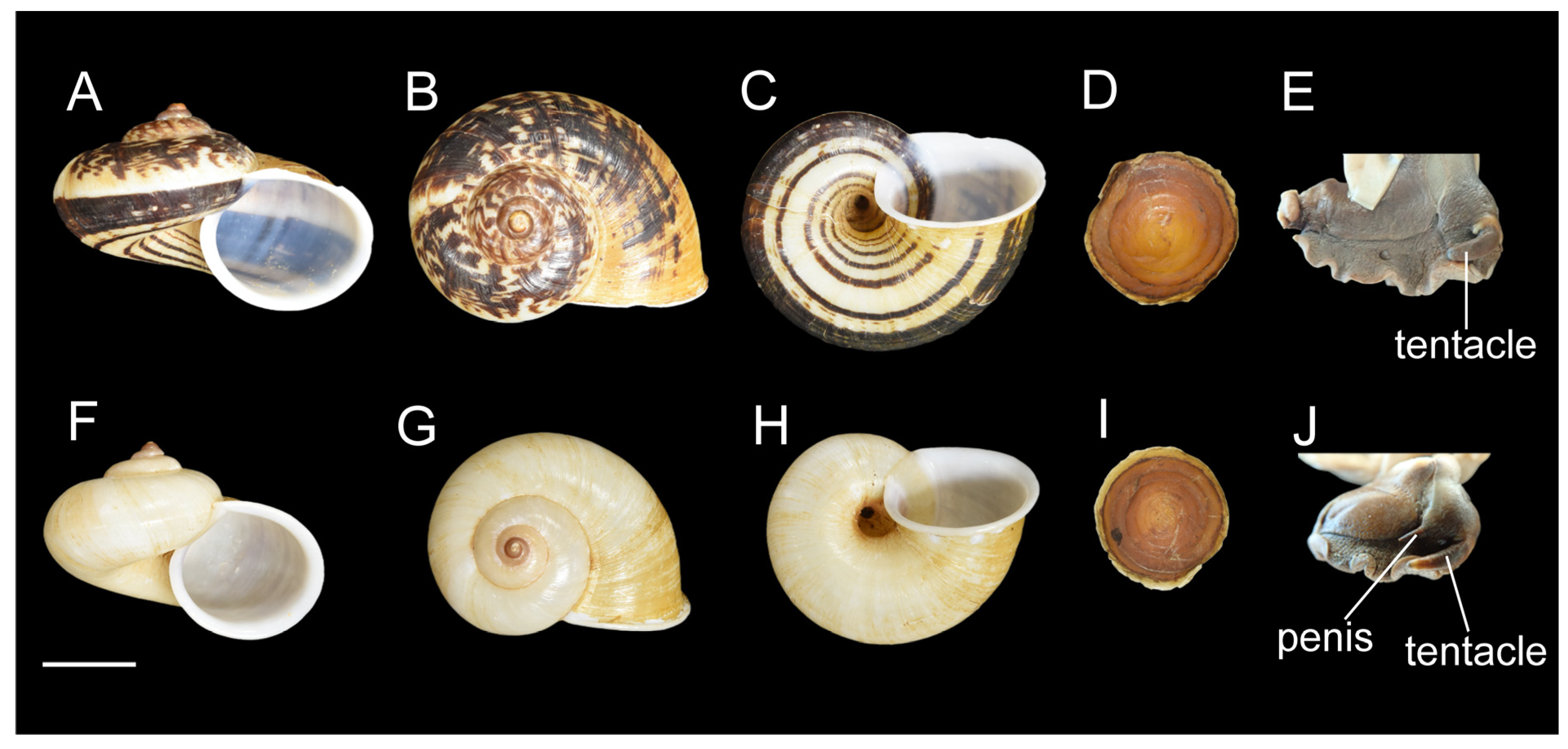Shell Color Diversity and Sexual Dimorphism in Land Snail Cyclophorus ateribalteiformis (Caenogastropoda: Cyclophoroidea): A Preliminary Observation
Abstract
Author Contributions
Funding
Institutional Review Board Statement
Data Availability Statement
Conflicts of Interest
References
- Schilthuizen, M.; Sipman, I.; Zwaan, H. Sexual dimorphism in shell coloration of Plectostoma (Caenogastropoda: Diplommatinidae) is caused by polyenes. J. Mollus. Stud. 2017, 84, 108–110. [Google Scholar] [CrossRef]
- Ponder, W.F.; Lindberg, D.R.; Ponder, J.M. Biology and Evolution of the Mollusca; CRC Press: Boca Raton, FL, USA, 2020; Volume 2, pp. 365–417. [Google Scholar]
- Ponder, W.F.; Lindberg, D.R. Phylogeny and Evolution of the Mollusca; University of California Press: Berkeley, CA, USA, 2008; pp. 331–383. [Google Scholar]
- Griffiths, R.J. Sexual dimorphism in Cypraeidae. J. Mollus. Stud. 1961, 34, 203–206. [Google Scholar] [CrossRef]
- Jokinen, E.H.; Guerette, J.; Kortmann, R.W. The Natural History of an Ovoviviparous Snail, Viviparus georgianus (Lea), in a Soft-Water Eutrophic Lake. Freshw. Invertebr. Biol. 1982, 1, 2–17. [Google Scholar] [CrossRef]
- Son, M.H.; Hughes, R.N. Sexual dimorphism of Nucella lapillus (Gastropoda: Muricidae) in North Wales, UK. J. Mollus. Stud. 2000, 66, 489–498. [Google Scholar] [CrossRef]
- Pastorino, G. Sexual dimorphism in shells of the southwestern Atlantic gastropod Olivella plata (Ihering, 1908) (Gastropoda: Olividae). J. Mollus. Stud. 2007, 73, 283–285. [Google Scholar] [CrossRef]
- Minton, R.L.; Wang, L.L. Evidence of sexual shape dimorphism in Viviparus (Gastropoda: Viviparidae). J. Mollus. Stud. 2011, 77, 315–317. [Google Scholar] [CrossRef]
- Márquez, F.; Averbuj, A. Sexual dimorphism in the shell of a nassariid gastropod. A 3D geometric morphometrics approach. J. Mar. Biol. Assoc. UK 2017, 97, 249–255. [Google Scholar] [CrossRef]
- Ng, T.P.T.; Rolán-Alvarez, E.; Dahlén, S.S.; Davies, M.S.; Estévez, D.; Stafford, R.; Williams, G.A. The causal relationship between sexual selection and sexual size dimorphism in marine gastropods. Anim. Behav. 2019, 148, 53–62. [Google Scholar] [CrossRef]
- Estebenet, A.L.; Cazzaniga, N.J. Sex-related differential growth in Pomacea canaliculata (Gastropoda: Ampullariidae). J. Mollus. Stud. 1998, 64, 119–123. [Google Scholar] [CrossRef]
- Gefaell, J.; Galindo, J.; Rolán-Alvarez, E. Shell color polymorphism in marine gastropods. Evol. Appl. 2023, 16, 202–222. [Google Scholar] [CrossRef] [PubMed]
- Phung, C.C.; Choo, M.H.; Liew, T.S. Sexual dimorphism in shell size of the land snail Leptopoma perlucidum (Caenogastropoda: Cyclophoridae). PeerJ 2022, 10, e13501. [Google Scholar] [CrossRef]
- Chen, D.N.; Zhang, G.Q. Description on new species and zoogeographical analysis of the land mollusks from Xishuangbanna and neighboring area, Yunnan Province (Gastropoda: Prosobranchia: Archaeogastropoda, Mesogastropoda). Acta Zootaxonomica Sin. 1998, 23, 346–356. [Google Scholar]
- Palumbi, S.R.; Martin, A.; Romano, S.; McMillan, W.O.; Stice, L.; Grabowski, G. The Simple Fool’s Guide to PCR; University of Hawaii: Honolulu, HI, USA, 1991. [Google Scholar]
- Folmer, O.; Black, M.; Hoeh, W.; Lutz, R.; Vrijenhoek, R. DNA Primers for Amplification of Mitochondrial Cytochrome c Oxidase Subunit I from Diverse Metazoan Invertebrates. Mol. Mar. Biol. Biotechnol. 1994, 3, 294–299. [Google Scholar]
- Chen, H.; Xie, G.L.; Li, J.X.; Chen, Z.G.; Dai, Y.T.; He, Y.M.; Xiang, H.Q.; Huang, X.C.; Wu, X.P. Hidden diversity in China’s Sky Islands: Three new freshwater snail species of Erhaiidae (Gastropoda, Truncatelloidea) from the Yunnan-Guizhou Plateau. Zoosyst. Evol. 2025, 101, 1359–1368. [Google Scholar] [CrossRef]
- Gofas, S. The systematics of Pyrenean and Cantabrian Cochlostoma (Gastropoda, Cyclophoroidea) revisited. J. Nat. Hist. 2001, 35, 1277–1369. [Google Scholar] [CrossRef]
- Raven, J.G.M. A revision of Obscurella Clessin, 1889 (Gastropoda Prosobranchia: Cyclophoridae). Basteria 1990, 54, 17–62. [Google Scholar]
- Reichenbach, F.; Baur, H.; Neubert, E. Sexual dimorphism in shells of Cochlostoma septemspirale (Caenogastropoda, Cyclophoroidea, Diplommatinidae, Cochlostomatinae). ZooKeys 2012, 208, 1–16. [Google Scholar] [CrossRef] [PubMed]
- Páll-Gergely, B.; Hunyadi, A.; Otani, J.U.; Ablett, J.D.; Schilthuizen, M. First record of striking sexual dimorphism in two terrestrial caenogastropods. J. Mollus. Stud. 2020, 86, 254–258. [Google Scholar] [CrossRef]


Disclaimer/Publisher’s Note: The statements, opinions and data contained in all publications are solely those of the individual author(s) and contributor(s) and not of MDPI and/or the editor(s). MDPI and/or the editor(s) disclaim responsibility for any injury to people or property resulting from any ideas, methods, instructions or products referred to in the content. |
© 2025 by the authors. Licensee MDPI, Basel, Switzerland. This article is an open access article distributed under the terms and conditions of the Creative Commons Attribution (CC BY) license (https://creativecommons.org/licenses/by/4.0/).
Share and Cite
Xie, G.-L.; Wang, Q.; Cao, Y.; Zhu, J.-Y.; Shu, F.-Y. Shell Color Diversity and Sexual Dimorphism in Land Snail Cyclophorus ateribalteiformis (Caenogastropoda: Cyclophoroidea): A Preliminary Observation. Diversity 2025, 17, 811. https://doi.org/10.3390/d17120811
Xie G-L, Wang Q, Cao Y, Zhu J-Y, Shu F-Y. Shell Color Diversity and Sexual Dimorphism in Land Snail Cyclophorus ateribalteiformis (Caenogastropoda: Cyclophoroidea): A Preliminary Observation. Diversity. 2025; 17(12):811. https://doi.org/10.3390/d17120811
Chicago/Turabian StyleXie, Guang-Long, Qin Wang, Ying Cao, Jia-Yi Zhu, and Feng-Yue Shu. 2025. "Shell Color Diversity and Sexual Dimorphism in Land Snail Cyclophorus ateribalteiformis (Caenogastropoda: Cyclophoroidea): A Preliminary Observation" Diversity 17, no. 12: 811. https://doi.org/10.3390/d17120811
APA StyleXie, G.-L., Wang, Q., Cao, Y., Zhu, J.-Y., & Shu, F.-Y. (2025). Shell Color Diversity and Sexual Dimorphism in Land Snail Cyclophorus ateribalteiformis (Caenogastropoda: Cyclophoroidea): A Preliminary Observation. Diversity, 17(12), 811. https://doi.org/10.3390/d17120811




